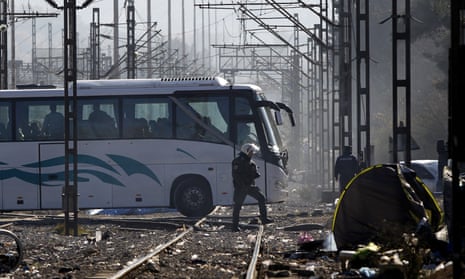Greece has dispersed more than 2,000 refugees who were stuck for weeks in a camp near the Macedonian border, as the EU announced that over 1 million people had now claimed asylum within its borders since the start of the year.
Syrians, Afghans and Iraqis continue to be allowed into Macedonia and the Balkans, but people of other nationalities, who make up roughly 10% of the total number, have been stopped at the border since early November. Instead of returning to Athens, many of them set up camp for several weeks – and several sewed shut their mouths – leading to Wednesday’s dispersal.
In separate developments, the EU said it had received at least 1 million asylum seekers in 2015, a figure that includes refugees who have crossed the Mediterranean as well as internal European migrants from Kosovo and Albania. It does not include numbers from the latest surge in maritime arrivals; on Wednesday 11 people were confirmed to have drowned in the Atlantic Ocean during an attempt to reach Spain’s Canary Islands by boat from west Africa.
In northern Greece, an activist and an aid worker said hundreds of Greek police arrived in the morning to disperse the camp, which includes asylum seekers from warring countries such as Somalia, as well as peaceful ones like Morocco. The vast majority went without protest, though some Iranians held a short demonstration at around midday, before being bussed back to Athens in a convoy of around 50 coaches.
“We haven’t seen any violence and we haven’t treated anybody for violence,” said Constance Theisen, a representative of Médecins Sans Frontières, which has been working in the area since the spring.
Aid workers are now preparing for chaotic scenes in Athens, where the rejected asylum seekers were due to spend the night in two stadiums, and where officials and campaigners have not decided on a joint strategy. “At the moment, you have IOM [the International Organisation for Migration] promoting voluntary returns [to their home countries],” said Theisen. “And you have UNHCR [the UN refugee agency] telling people how to apply for asylum.”

Other observers speculate that those who have been returned to Athens will not remain for long, with many expected to try to reach northern Europe via Bulgaria or Albania instead. “Let’s wait for the new route, because we will see it soon,” said Vasilis Tsartsanis, an activist who has been working on the Macedonian border for more than a year. “They will go again to the mafia and the smugglers.”
Meanwhile, the bodies of 11 migrants attempting to reach Spain’s Canary Islands by boat were recovered on Tuesday, the latest victims of a perilous migration route that appears to be regaining popularity with sub-Saharan migrants desperate to make it to Europe.
The 11 were believed to be on a small boat packed with 39 people that set off from Western Sahara two days earlier, in the hope of making it across the treacherous stretch of the Atlantic Ocean that separates the Canary Islands from west Africa. Moroccan authorities said the boat capsized after it ran into poor weather conditions. There were no reports on the whereabouts of the others on the boat.
It was the third boat attempting the crossing in as many days. On Sunday, the Spanish coastguard rescued 51 people making the journey, and on Monday another 47 people.
The crossings represent a small revival in attempts to reach one of Europe’s southernmost outposts. Rough estimates suggest that more than 400 people have arrived in the Spanish archipelago since the start of the year, up from 296 in 2014 – the highest annual total since 2009. Some 270 migrants and refugees arrived in September and October alone.
The numbers arriving on the islands nevertheless remain a far cry far from those in 2006, when more than 31,000 migrants arrived in the Canary Islands. Hundreds of others drowned or died of thirst and exposure while attempting the journey, which can take up to two weeks.
At the time, Spanish authorities responded to the surge by increasing coastguard patrols and signing repatriation agreements with several African countries. The number of migrants dropped substantially, to as low as 196 in 2013, according to Spain’s interior ministry.
Many migrants instead tried their luck on the triple razor-wire fence that lines the borders of the Spanish enclave of Melilla, which more than 2,000 migrants and refugees managed to scale in 2014. In response, Spanish authorities added a fine layer of mesh to make it tougher to climb and passed a controversial law allowing border guards to forcibly return anyone who makes it over the fence to Morocco. The number of migrants making across the fence this year has since dropped to around 100 people.

Comments (…)
Sign in or create your Guardian account to join the discussion